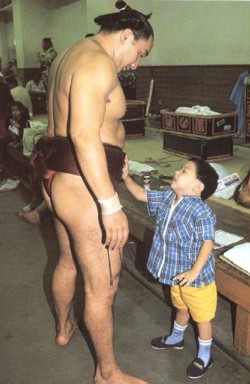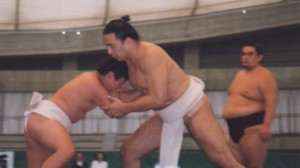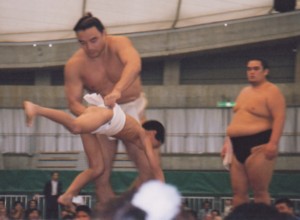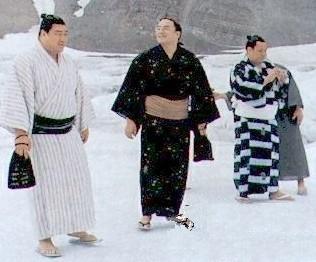 Terao: The Eternal Typhoon
Terao: The Eternal Typhoon
|
In The Beginning Training The Long Walk Tournaments Media Restaurant Retirement Oyokata Terao's Official Site - in Japanese
|
Terao's heya was the Isutza heya, run by his father as oyokata. Sumo rikishi (wrestler is not really an apt term) go through several ranks. They start at sandanme, then jonokuchi, and finally juryo - the "minor league" of the Sumo world. Each basho, for juryo and above, features 15 days of matches. Rikishi must make kachi-kochi - a winning record of 8-7, to maintain their current rank. Each win over 8 propels them a bit higher in the rankings. Juryo rikishi ranked 1 or 2, who have a winning basho, are promoted to the Makuuchi division for the next basho (while rikishi ranked 15 or 16 in makuuchi, who have a losing record, drop to Juryo. New rikishi from Juryo invariably enter on the lowest rung of the Makuuchi ladder, and if they have a losing record they drop back down to juryo. The skilled rikishi soon return to Makuuchi.
 ... ... ... ... Photos supplied by Barbara Ann Klein.
TrainingBetween bashos, selected rikishi go on tour through certain remote cities and towns giving demonstrations of sumo. There's no high tech equipment available there so rikishi train with free weights.The sumo dohyos themselves aren't known for their high-tech equipment. The rikishi train with free weights, do a lot of stretching, and a lot of bouting.
Heya life The coach of the sumo heya is called the Oyokata. When a rikishi retires, he has few options open to him. Becoming an oyokata is one that only a few rikishi can achieve, because they must have family connections or friends. (Terao's brother, Sakahoko, is now the oyokata of Isutzu, Terao's old beya, while he is now oyokata of another, new stable, Shikoroyama.) The history of Isutzu, as with most heya, is a long one. According to wikipedia: "The stable was established in the Meiji era by former yokozuna Nishinoumi Kajirō I, the 16th yokozuna, who became the 7th Izutsu-oyakata. He was succeeded by Nishinoumi Kajirō II, the 25th yokozuna. Today, the stable remains in the hands of the same family, having passed through his grandson-in-law Tsurugamine Akio to then to his son Sakahoko Nobushige."
Exhibitions

The sumotoria have visited other countries - including Canada and the US, to give demonstrations. The photos below are from their trip to Canada in 1995, provided by Barbara Anne Klein.

|




